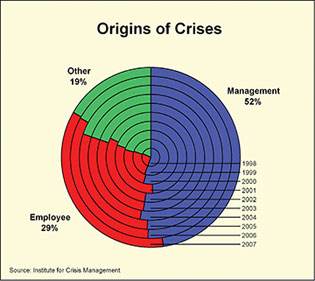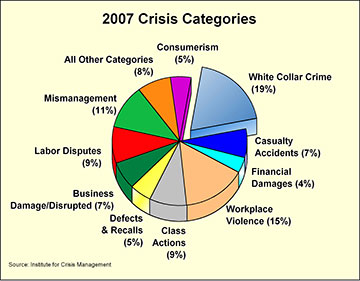The Institute for Crisis Management recently released its annual Crisis Report, which detailed the state of business crises during 2007. Defined as "any problem or disruption
that triggers negative stakeholder reactions that could impact the organization's financial strength and ability to do what it does," these business crises represent a significant
portion of communicators' responsibilities within their own organizations; the findings themselves shed light on the origins of last year's biggest business crises (see chart
below, left), as well as the organizations that were most affected.
The business landscape was marked by the subprime debacle; mismanagement and white-collar crime (American Red Cross, UnitedHealth Group, Nortel Networks); product recalls
(Mattel, ChemNutra Company, Menu Foods, Hasbro, GE, Toyota and Ford are a few of many); unexpected crises (Virginia Tech shooting, coal-mine collapses); personal data security
breaches.
The findings revealed that executives and managers continued to be responsible for just over half of all crises that strike organizations. Employees triggered 29%, and outside
forces accounted for the remaining 19%, on average, over the past 10 years.
In terms of the types of crises that plague businesses, the report singled out 16 separate categories, including consumer activism, mismanagement, environmental, hostile
takeovers and white-collar crime (see chart below, right). The latter category accounted for the highest percentage of crises in 2007 (19%), followed by workplace violence (15%)
and mismanagement (11%).
These crises can predominately be categorized as "smoldering," as opposed to sudden crises that strike unexpectedly. In fact, the report shows that 65% of all crises are
smoldering--a bad sign for communications professionals, considering these are often preventable.
"For the most part, the study reinforces that the majority of crises are smoldering, which organizations should be able to spot and fix," says Larry Smith, president of the
Institute for Crisis Management. "The people who run organizations need to be listening, and they're not doing enough of that anymore. More people are talking through blogs and
online platforms, but executives tend to tune it out."
In addition to analyzing the major business crises of 2007, the report offers analyses of the actions taken by the organizations in question. For example, the report chastised
Robert Murray, the owner of a coal mine that collapsed in Utah, as "the imperfect example of all the wrong things to do after a crisis" due to his poor management of the crisis.
The report emphasizes that the CEO should not have been the ongoing spokesperson, as there is no one to step in and fix problems that inevitably happen with an untrained CEO
misspeaks or mishandles ?inquiries.
Based on the major 2007 business crises, Smith offers these additional best practices:
-
Have a plan--an operations plan, a communication plan and a continuity/business recovery plan;
-
Identify and train spokespeople beforehand, and agree what they will say, to whom they will say it and how the will deliver it;
-
Remember that internal audiences are almost always the most important; and
-
Pay attention to what your employees are saying, your customers are doing, the media is reporting and bloggers are writing.
CONTACT:
Larry Smith, [email protected]
 |
 |
